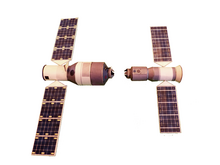Space station


Space stations are spacecraft that are mostly in the orbit of a celestial body and allow people to live on them for a long time. Since they themselves do not have a propulsion system for locomotion or landing equipment, they are dependent on spacecraft for transport. Room laboratories are a sub-form of space stations .
Problems
The technical challenge when operating a space station is, above all, supplying the crew. Due to the high costs of transport, systems had to be developed that allow the operation of a space station to be largely self-sufficient, i.e. H. in a closed circuit. Great progress has been made, especially in the treatment of water and air.
The orbit around the earth is not stable at a height of 300 kilometers, as a very thin earth atmosphere constantly slows down the space stations. Without regular thrust into higher orbits, space stations would therefore re-enter the earth's atmosphere after a few months or years. The gravity of other celestial bodies could also disturb the orbit of a space station. Space stations therefore need a constant supply, especially of fuel for course correction.
The space stations in detail
The first space station was the Soviet Salyut 1 in 1971 . One of the most important space stations was the Soviet Mir station , which was gradually expanded and used for almost 15 years. With the ISS , a space station is now permanently manned in international cooperation.
To date, thirteen space stations have been put into orbit, eleven of which have been manned:
| Surname | begin | crash | Number of long-term crews |
Busy days |
Mass in kg b) |
comment |
|---|---|---|---|---|---|---|
| Salyut 1 | April 19, 1971 | October 11, 1971 | 1 | 24 | 18,500 | All three crew members died on the return flight in Soyuz 11 upon re-entry. |
| Salyut 2 | 3rd April 1973 | May 28, 1973 | 0 | 0 | 18,500 | Loss of pressure and instrument failure caused the station to crash prematurely |
| Cosmos 557 | May 11, 1973 | May 22, 1973 | 0 | 0 | 19,400 | did not reach a stable orbit |
| Skylab | May 14, 1973 | July 11, 1979 | 3 | 171 | 77,088 | so far the only purely US space station |
| Salyut 3 | June 24, 1974 | January 24, 1975 | 1 | 15th | 18,500 | |
| Salyut 4 | December 26, 1974 | 2nd February 1977 | 2 | 92 | 18,500 | |
| Salyut 5 | June 22, 1976 | August 8, 1977 | 2 | 67 | 19,000 | |
| Salyut 6 | 29th September 1977 | July 29, 1982 | 6th | 683 | 19,824 | first refuelable space station |
| Salyut 7 | April 19, 1982 | February 7, 1991 | 5 | 816 | 18,900 | |
| Me | February 19, 1986 | March 23, 2001 | 28 | 4594 | 124,340 | largest Russian space station to date |
| ISS | November 20, 1998 | (still in orbit) | so far 65 | 7471 a) | 455,000 | under international cooperation, four Russian modules are still missing ( Nauka , two Science Power Modules and a small coupling module ) |
| Tiangong 1 | September 29, 2011 | April 2, 2018 | 2 | 21 | 8,506 | first Chinese space station |
| Tiangong 2 | 15th September 2016 | 19th July 2019 | 1 | 30th | 8,600 |
Planned space stations
According to the plans of the Chinese space organization CNSA, a permanently manned space station is to follow as the successor to Tiangong 1 and Tiangong 2 by 2022 . NASA wants to operate the Lunar Orbital Platform-Gateway space station with the ISS partners from 2024 . India is planning its own space station for around 2030.
Possible future development
Future space stations could be positioned at a greater distance from the earth in one of the Lagrange points of the earth-moon system. The Lagrange points L 4 and L 5 enable the space station to have a much more stable orbit, which would significantly reduce the necessary course corrections and thus fuel consumption. However, the intensity of cosmic rays is considerably greater at a greater distance from the earth, because there is no protection from the earth's magnetosphere . For such a space station it would be necessary to take special precautions for radiation protection .
One possible concept for future space stations would be the O'Neill colonies , for example .
See also
- List of manned missions to the Mir space station
- List of manned missions to the International Space Station
- Space travel
literature
- Philip Baker: The Story of Manned Space Stations - An Introduction. Springer, Berlin 2007, ISBN 978-0-387-30775-6 .
- Roger D. Launius: Space station - base camps to the stars. Smithonian, Washington DC 2003, ISBN 1-58834-120-8 .
- Ernst Messerschmid et al .: Space Stations - Systems and Utilization. Springer, Berlin 1999, ISBN 978-3-642-08479-9 .
Web links
Individual evidence
- ↑ Tiangong 1 burns up in the earth's atmosphere. Süddeutsche Zeitung, April 2, 2018, accessed on April 2, 2018 .
- ↑ Chinese space station "Tiangong-2" over the South Pacific burned up in the atmosphere. July 19, 2019. Retrieved July 19, 2019 .
- ↑ China to Launch Tiangong-2 Space Lab in 2016: Astronaut. CRIENGLISH.com, September 10, 2014, accessed September 11, 2014 .
- ↑ China plans to launch core module of space station around 2018. People's Daily Online, April 21, 2016, accessed September 15, 2016 .
- ↑ Huma Siddiqui: India to have its own space station! ISRO plans to take historic leap. In: The Hindu . June 13, 2019, accessed June 13, 2019 .



